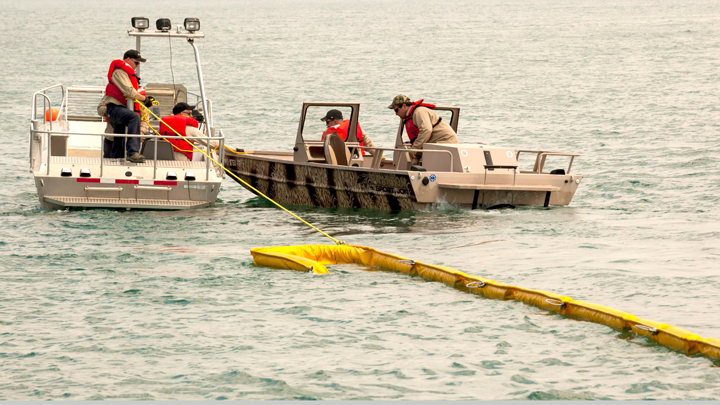
Trump’s 97 Percent Cut for Great Lakes? That Was the Good News
By Jennifer Lu
InquireFirst
About 90 civic leaders from the Great Lakes region rallied Wednesday on a snowy corner of Capitol Hill in Washington, D.C., their voices barely audible above the 30 mph winds. They were there to express their concerns about a Trump administration proposal to reduce funding for Great Lakes improvement projects by 97 percent.
The rally was barely over when the news began trickling in: The administration’s final budget, due to be released the next morning, wouldn’t just slash $290 million from the $300 million Great Lakes Restoration Initiative—it would cut the program entirely.
Titled “America First: A Budget Blueprint to Make America Great Again,” Trump’s budget would make state and local governments responsible for regional environmental projects. That would leave the U.S. Environmental Protection Agency to “focus on its highest national priorities,” the budget said.
“To suggest that our region is not of national significance is frankly an insult,” said Todd Ambs, director of the Healing Our Waters-Great Lakes Coalition and one of the speakers who stood in the cold. “It’s astonishing. The White House needs a geography lesson.”
Ambs had flown in from Wisconsin for Great Lakes Day, an annual event planned long before the administration’s budget plans were known. Each year, groups from the region travel to Washington to meet with legislators and share suggestions for bills and appropriations to protect their environment and support their economy.
Since 2010, almost $1.8 billion has flowed into the region through the Great Lakes Restoration Initiative, an interagency program headed by the EPA. The money goes to cleanup, conservation, scientific research and monitoring projects.

The administration’s plan would cut the overall budget for the EPA—the agency charged with safeguarding the nation’s air and water—by 31 percent, reducing it to $5.7 billion. That’s a little more than a quarter of the projected cost of the wall President Trump has pledged to build along the U.S.-Mexico border.
Other federal agencies and departments that provide vital services to the Great Lakes would also face dramatic reductions. The budget “zeroes out” more than $250 million in funding to the National Oceanic and Atmospheric Administration, including NOAA’s Sea Grant programs. These grants support coastal and marine research and education at 33 universities, including four in the Great Lakes.
The Great Lakes supply drinking water to 35 million people in eight states and Canada. Although they are cleaner and healthier than they were in the 1960s and ‘70s, they are still threatened by known and emerging contaminants. They are also plagued with algal blooms, which returned to Lake Erie in the late ‘90s, a result of phosphorus-rich farm runoff entering the lakes’ streams and tributaries.
“It feels as though the federal administration is really unaware of how big this issue is when they would allow for those kinds of cuts to even be documented on the budget,” said Tina Wozniak, county commissioner for Lucas County, Ohio.
Residents of Lucas County, which includes the city of Toledo, went without drinking water for three days in 2014 when their water system was overwhelmed by toxins from an algal bloom on Lake Erie. Great Lakes funding is helping them upgrade their water treatment plant, restore wetlands that slow farm runoff and clean up beaches to improve tourism.
Without federal support, this type of work could come to a “screeching halt,” said Gail Hesse, the National Wildlife Federation’s Great Lakes Water Program Director. “A 31 percent cut is pretty devastating…So what do you pick? Invasive species, restorations, water quality?”
Before Hesse joined the Wildlife Federation, she spent 32 years with the Ohio EPA. States rely largely on EPA funding to comply with the Clean Water Act, Clean Air Act and Safe Drinking Water Act—regulations that are vital to public and environmental health, she said. “It’s not accurate to say that by rolling back the U.S. EPA, the states can pick up the slack.”
A 2005 study by the Great Lakes Regional Collaboration, a state and federal partnership, determined that $20 billion in federal and state investment was needed to restore the lakes.
“You cannot lowball the program, reduce staffing and the agency’s budget and hope that the agency will still run itself,” said Cameron Davis, a former senior advisor to former EPA administrator Gina McCarthy for the Great Lakes region. “It won’t work.”
Ambs, the Great Lakes advocate from Wisconsin, said he’ll do everything he can to save the Great Lakes.
“We are visiting literally every congressional office in the Great Lakes region to enlist support to battle cuts to GLRI and its agencies,” he said Thursday. “We’re ready, we’re charged up, we’re here to tell the story of the Great Lakes.”
That morning, Ambs had attended a Great Lakes Day breakfast meeting with members of Congress who represent the region. He said he heard only bipartisan support for the Great Lakes Restoration Initiative.
Ohio U.S. Representative Marcy Kaptur, a Democrat whose district borders the western basin of Lake Erie where algal blooms are most severe, released a statement reminding the White House that “under the Constitution it is the Congress that holds the power of the purse. I hope my Republican colleagues on the Appropriations Committee remain committed to a collegial and cooperative process, that yields good results for the American people.”
Republican Rob Portman, a junior senator from Ohio, posted on Twitter, “I strongly oppose the president’s budget request to eliminate funding for the #GreatLakes Restoration Initiative.”
U.S. Representative Fred Upton, a Republican from Michigan, tweeted that while he thinks the president’s plan “does attempt to put us on the path to fiscal responsibility,” he “remain(s) deeply concerned about proposed cuts to important domestic programs like the NIH and especially to our #GreatLakes.”
But even if Congress restores some of the funding, scientist Bradley Cardinale warns that the EPA and other agencies targeted for cuts will still suffer.
“He (Trump) has scared a lot of people,” said Cardinale, who directs the Cooperative Institute for Limnology and Ecosystems Research, a joint NOAA-University of Michigan cooperative. “There’s going to be a mass exodus out of these agencies. There’s a brain drain and personnel and staff drain….It’s going to take decades (for those agencies) to come back up.”
Jennifer Lu is an InquireFirst intern. Her work is funded by a Larry J. Waller Investigative Reporting Fellowship from the University of Missouri and support from the Council for the Advancement of Science Writing through The Brinson Foundation.
